Enceladus is the sixth-largest moon of Saturn and one of the top targets in the search for life within our Solar System.
Observations made by NASA’s Cassini spacecraft have shown that this small moon of Saturn has a subsurface ocean of water that erupts into space, creating an environment that contains nearly all the essential requirements for life as we know it. In a new study, scientists from the United States, Australia, China, and Germany conducted geochemical modeling to predict the potential biogenic elemental phosphorus in the ocean of Enceladus.
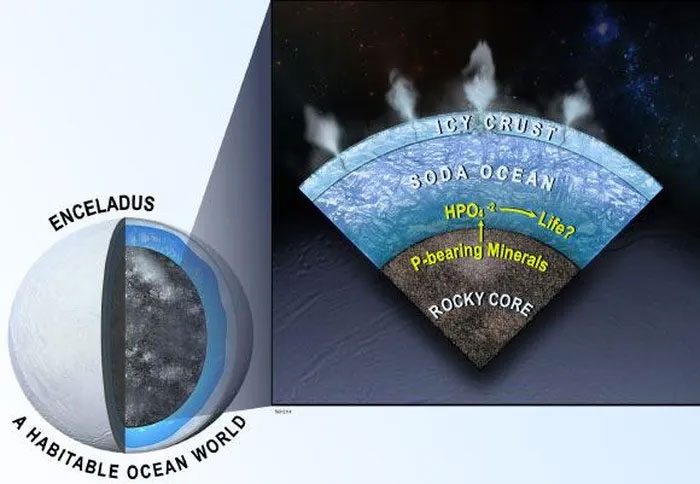
Orthophosphate phosphorus may be abundant in the subsurface ocean of Saturn’s moon Enceladus; the model indicates that this interaction promotes the dissolution of phosphate minerals, making orthophosphate available for potential life in the ocean; because phosphorus is an essential component for life, this discovery further strengthens the evidence for habitability within this small moon of Saturn.
The search for habitable planets is often linked to the presence of liquid water.
Beyond Earth, oceans of water also exist beneath the surfaces of several icy celestial bodies – for example, Enceladus, Europa, and Titan – outside the Solar System.
Based on these premises, Enceladus is considered a place with factors suitable for life on Earth, as this moon has water-rich plumes erupting from a subsurface ocean.
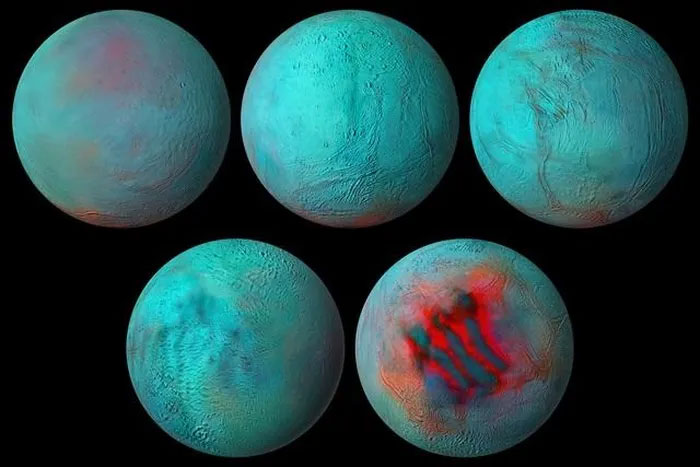
Enceladus is the sixth-largest moon of Saturn. It was discovered by the astronomer William Herschel in 1789. Enceladus has a diameter of about 500 km, which is one-tenth the size of Titan, Saturn’s largest moon. It is the most reflective body in the Solar System (almost 100%). Before the 1980s (when two Voyager spacecraft flew past Enceladus), very little was known about Enceladus beyond the fact that it had water on its surface.
Dr. Christopher Glein, the lead scientist at the Southwest Research Institute, stated: “What we are studying shows that these plumes contain nearly all the basic requirements for life as we know it.”
“While the potential biogenic phosphorus has not yet been directly identified, our team has found evidence of its availability in the ocean beneath the icy crust of this moon.”
Phosphorus in the form of phosphate is crucial for all life on Earth. This element is necessary for the creation of DNA and RNA, energy-carrying molecules, cell membranes, bones, and teeth in humans and animals, and even for the marine microbial ecosystems.
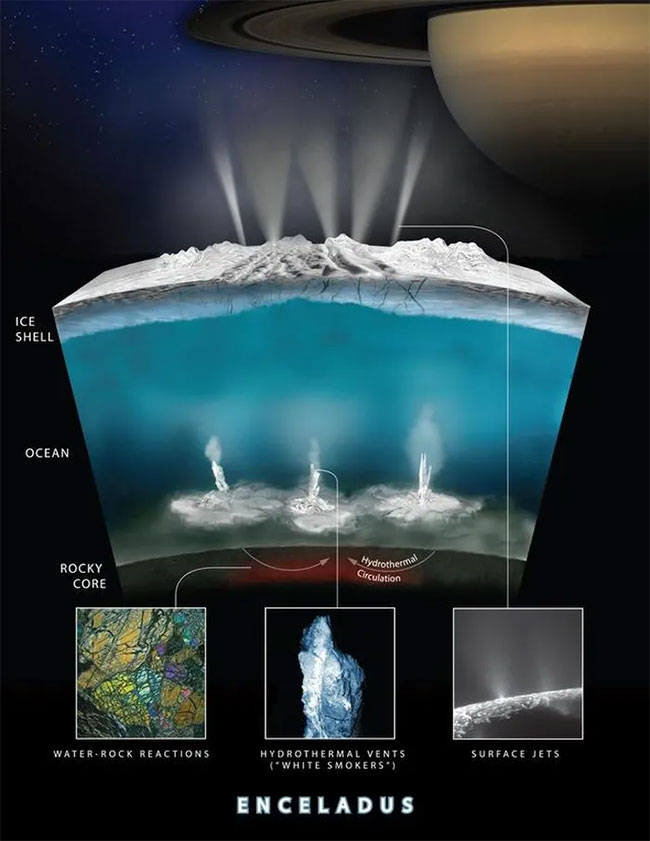
Scientists discovered geysers erupting in the southern polar region of this Saturn moon in 2005 during the initial exploration phase of the Cassini-Huygens spacecraft, a collaborative project between NASA and the European Space Agency. These geysers contribute new material to the ring surrounding Saturn, originating from an ocean approximately 9.7 km thick located beneath a 31-40 km thick icy crust, above a rocky core. They erupt from a series of fissures known as “tiger stripes” near the southern pole of Enceladus.
In their study, Dr. Glein and his colleagues performed kinetic and thermodynamic modeling simulating the geochemistry of phosphorus based on insights from Cassini about the ocean floor system on Enceladus.
This can be considered the most detailed geochemical model to date regarding how minerals on the ocean floor dissolve into Enceladus’s ocean and predicts that phosphate minerals will dissolve unusually there.
Dr. Glein mentioned: “This new study shows the presence of dissolved phosphorus on Saturn’s sixth moon, which may reach levels close to or even higher than those in modern Earth’s seawater.”
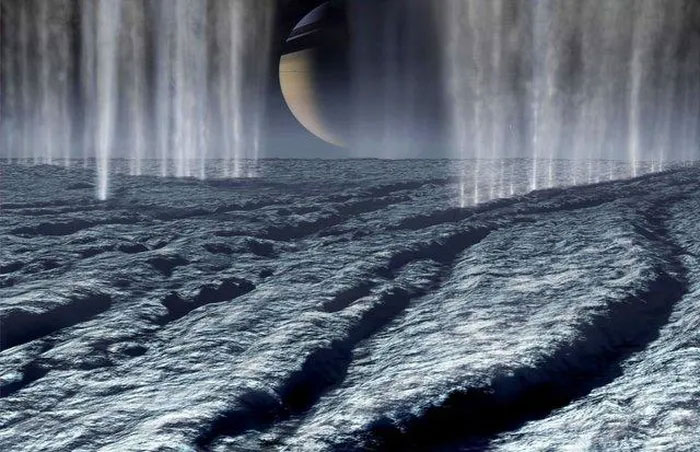
In late 2008, scientists detected water vapor rising from the surface of Enceladus. This proved that there is water on this moon, and thus, there could be life. Candice Hansen, a scientist at NASA’s Jet Propulsion Laboratory in California, led a team of scientists studying the gas plume on Enceladus. Previously, they had calculated the ejection speed of the gas plume to be approximately 2,189 km/h. This speed is unusually high and may be related to water. They decided to conduct a detailed study of the composition of the gas plume.
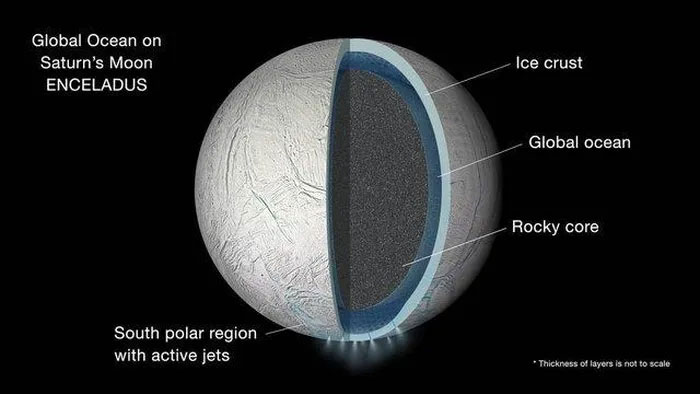
A high initial temperature model suggests that Enceladus began as a mixed ball of ice and rock and contained rapidly decaying radioactive isotopes of aluminum and iron. The decay of these isotopes over about 7 million years generated a significant amount of heat. As a result, rock materials solidified in its core, surrounded by an icy crust. According to this hypothesis, the remaining radioactive decay slowly in the core, along with tidal forces from Saturn’s gravitational pull, could continue to warm and melt its interior core for billions of years. Evidence from the Cassini spacecraft indicates that beneath the surface ice of Enceladus may lie an ocean covering the entire moon. The ice crystals analyzed by Cassini have shown that they are saltwater ice. It is estimated that such saltwater can only occur in a very large volume of water. Therefore, Enceladus becomes an excellent location for the emergence of extraterrestrial life. Additionally, there is a hypothesis that the water source originates from a vast ocean beneath the surface of Enceladus.


















































